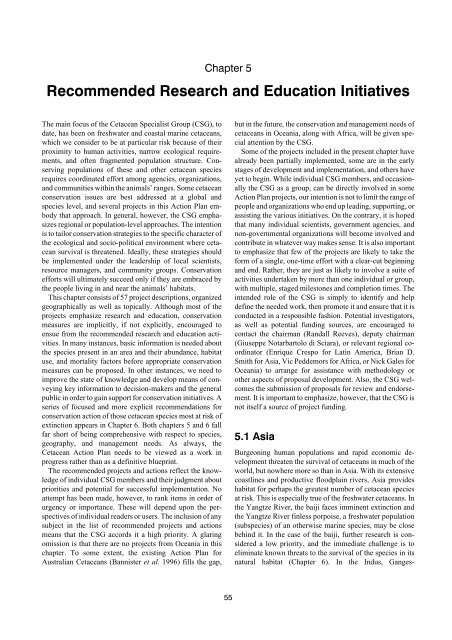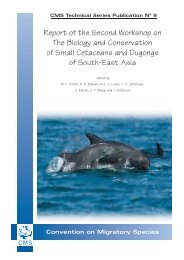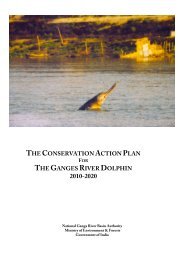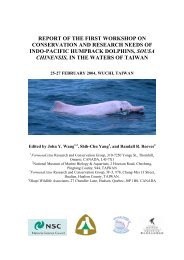Dolphins, Whales and Porpoises: 2002-2010 Conservation - IUCN
Dolphins, Whales and Porpoises: 2002-2010 Conservation - IUCN
Dolphins, Whales and Porpoises: 2002-2010 Conservation - IUCN
You also want an ePaper? Increase the reach of your titles
YUMPU automatically turns print PDFs into web optimized ePapers that Google loves.
Chapter 5<br />
Recommended Research <strong>and</strong> Education Initiatives<br />
The main focus of the Cetacean Specialist Group (CSG), to<br />
date, has been on freshwater <strong>and</strong> coastal marine cetaceans,<br />
which we consider to be at particular risk because of their<br />
proximity to human activities, narrow ecological requirements,<br />
<strong>and</strong> often fragmented population structure. Conserving<br />
populations of these <strong>and</strong> other cetacean species<br />
requires coordinated effort among agencies, organizations,<br />
<strong>and</strong> communities within the animals’ ranges. Some cetacean<br />
conservation issues are best addressed at a global <strong>and</strong><br />
species level, <strong>and</strong> several projects in this Action Plan embody<br />
that approach. In general, however, the CSG emphasizes<br />
regional or population-level approaches. The intention<br />
is to tailor conservation strategies to the specific character of<br />
the ecological <strong>and</strong> socio-political environment where cetacean<br />
survival is threatened. Ideally, these strategies should<br />
be implemented under the leadership of local scientists,<br />
resource managers, <strong>and</strong> community groups. <strong>Conservation</strong><br />
efforts will ultimately succeed only if they are embraced by<br />
the people living in <strong>and</strong> near the animals’ habitats.<br />
This chapter consists of 57 project descriptions, organized<br />
geographically as well as topically. Although most of the<br />
projects emphasize research <strong>and</strong> education, conservation<br />
measures are implicitly, if not explicitly, encouraged to<br />
ensue from the recommended research <strong>and</strong> education activities.<br />
In many instances, basic information is needed about<br />
the species present in an area <strong>and</strong> their abundance, habitat<br />
use, <strong>and</strong> mortality factors before appropriate conservation<br />
measures can be proposed. In other instances, we need to<br />
improve the state of knowledge <strong>and</strong> develop means of conveying<br />
key information to decision-makers <strong>and</strong> the general<br />
public in order to gain support for conservation initiatives. A<br />
series of focused <strong>and</strong> more explicit recommendations for<br />
conservation action of those cetacean species most at risk of<br />
extinction appears in Chapter 6. Both chapters 5 <strong>and</strong> 6 fall<br />
far short of being comprehensive with respect to species,<br />
geography, <strong>and</strong> management needs. As always, the<br />
Cetacean Action Plan needs to be viewed as a work in<br />
progress rather than as a definitive blueprint.<br />
The recommended projects <strong>and</strong> actions reflect the knowledge<br />
of individual CSG members <strong>and</strong> their judgment about<br />
priorities <strong>and</strong> potential for successful implementation. No<br />
attempt has been made, however, to rank items in order of<br />
urgency or importance. These will depend upon the perspectives<br />
of individual readers or users. The inclusion of any<br />
subject in the list of recommended projects <strong>and</strong> actions<br />
means that the CSG accords it a high priority. A glaring<br />
omission is that there are no projects from Oceania in this<br />
chapter. To some extent, the existing Action Plan for<br />
Australian Cetaceans (Bannister et al. 1996) fills the gap,<br />
but in the future, the conservation <strong>and</strong> management needs of<br />
cetaceans in Oceania, along with Africa, will be given special<br />
attention by the CSG.<br />
Some of the projects included in the present chapter have<br />
already been partially implemented, some are in the early<br />
stages of development <strong>and</strong> implementation, <strong>and</strong> others have<br />
yet to begin. While individual CSG members, <strong>and</strong> occasionally<br />
the CSG as a group, can be directly involved in some<br />
Action Plan projects, our intention is not to limit the range of<br />
people <strong>and</strong> organizations who end up leading, supporting, or<br />
assisting the various initiatives. On the contrary, it is hoped<br />
that many individual scientists, government agencies, <strong>and</strong><br />
non-governmental organizations will become involved <strong>and</strong><br />
contribute in whatever way makes sense. It is also important<br />
to emphasize that few of the projects are likely to take the<br />
form of a single, one-time effort with a clear-cut beginning<br />
<strong>and</strong> end. Rather, they are just as likely to involve a suite of<br />
activities undertaken by more than one individual or group,<br />
with multiple, staged milestones <strong>and</strong> completion times. The<br />
intended role of the CSG is simply to identify <strong>and</strong> help<br />
define the needed work, then promote it <strong>and</strong> ensure that it is<br />
conducted in a responsible fashion. Potential investigators,<br />
as well as potential funding sources, are encouraged to<br />
contact the chairman (R<strong>and</strong>all Reeves), deputy chairman<br />
(Giuseppe Notarbartolo di Sciara), or relevant regional coordinator<br />
(Enrique Crespo for Latin America, Brian D.<br />
Smith for Asia, Vic Peddemors for Africa, or Nick Gales for<br />
Oceania) to arrange for assistance with methodology or<br />
other aspects of proposal development. Also, the CSG welcomes<br />
the submission of proposals for review <strong>and</strong> endorsement.<br />
It is important to emphasize, however, that the CSG is<br />
not itself a source of project funding.<br />
5.1 Asia<br />
Burgeoning human populations <strong>and</strong> rapid economic development<br />
threaten the survival of cetaceans in much of the<br />
world, but nowhere more so than in Asia. With its extensive<br />
coastlines <strong>and</strong> productive floodplain rivers, Asia provides<br />
habitat for perhaps the greatest number of cetacean species<br />
at risk. This is especially true of the freshwater cetaceans. In<br />
the Yangtze River, the baiji faces imminent extinction <strong>and</strong><br />
the Yangtze River finless porpoise, a freshwater population<br />
(subspecies) of an otherwise marine species, may be close<br />
behind it. In the case of the baiji, further research is considered<br />
a low priority, <strong>and</strong> the immediate challenge is to<br />
eliminate known threats to the survival of the species in its<br />
natural habitat (Chapter 6). In the Indus, Ganges-<br />
55





